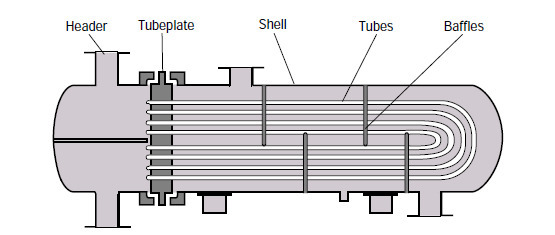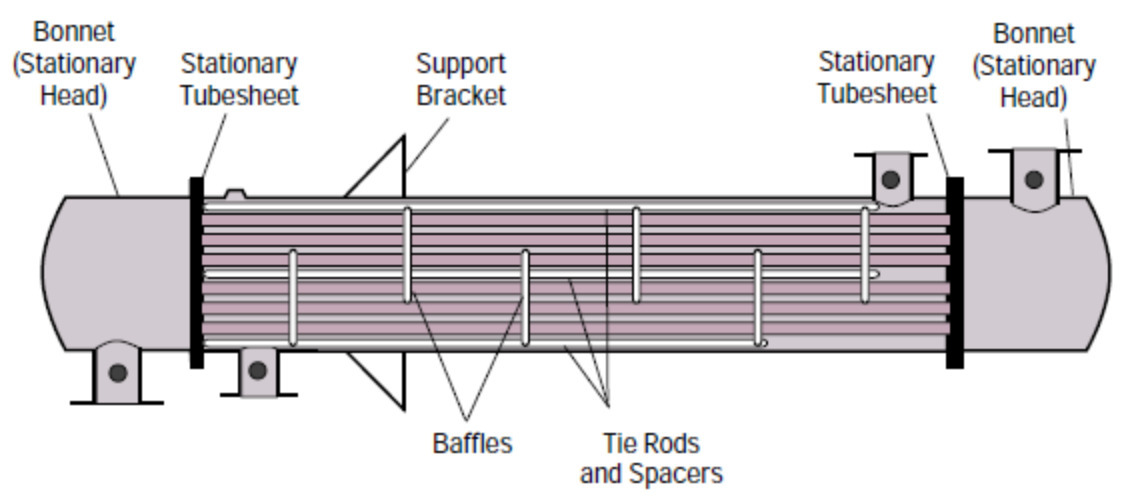Table of Contents
Heat Exchanger
Heat exchangers are devices that are used to transfer heat between two flows (liquid or gas) without physically mixing them. This is done by having a physical barrier between them which acts as the medium to transfer the energy from one flow to the other. There are many different types of heat exchangers mainly because there are a variety of ways each design fulfills its purpose. [1]
Double Pipe Heat Exchanger
A double pipe heat exchanger is a simple design in which one pipe is held concentrically inside a larger one. The inner pipe acts as the conductive barrier between the fluid flowing within the inner pipe and inside the larger pipe. [1]
Advantages:
- Can be used for high pressure and temperature environments
- Parts are standardized, meaning repair and souring parts is easy
- Flexible designs allow for easy addition and removal of parts
- Small footprint that requires little maintenance space
Disadvantages:
- Although parallel flow is possible, most designs use counter flow which would restrict some applications.
- When combining multiple units, it is prone to leaking
- Difficult to clean
- Less efficient than shell and tube exchangers [1]
For some background theory including equations and calculations, visit the link https://cheguide.com/double_pipe.html.
Double Pipe Heat Exchanger. [1] |
|---|
Plate and Frame Heat Exchanger
Plate and Frame heat exchangers are designed by stacking together plates which create a high turbulence and wall sheer stress, which both intern lead to a high heat transfer coefficient and high fouling resistance. The two fluids are fed into alternating plates and flow counter currently. The fluid with higher temperature travels up down one plate while the colder fluid travels up the neighboring plates. [3]
Advantages:
- High heat transfer coefficient
- Compact design
- Easy to maintain and clean
- Great for sterile environments
- Works well with low temperature differences
Disadvantages:
- Prone to leaking if not assembled properly
- High pressure difference leads to expensive pumps
- Not great for high temperature differences between fluids and high fluid temperatures in general [3]
An important note is the plate and frame heat exchangers can be externally insulated to reduce heat loss, which are usually removable. This is because plate and frame heat exchangers are regularly maintained, so permanent insulation is not practical. [3]
Plate and Frame Heat Exchanger Types:
- Gasketed plate: Designed to seal plates together to prevent leaks, but also used for easy removal, expansion, and cleaning of existing systems.
- Brazed Plate: Used stainless steel plates that are brazed with copper to prevent corrosion. They are efficient, compact, and economically feasible mainly used in refrigeration.
- Welded plate: Similar to the Gasketed plate however the plates are welded together, making them extremely durable and ideal for high temperatures or corrosive fluids.
- Semi-Welded plate: A hybrid of Gasketed and Welded plates, where pairs of welded plates are combined together in a similar style to the Gasketed design. Great for easy maintenance and leak control. [3]
For some background theory including equations and calculations, visit the link https://www.alfalaval.com/microsites/gphe/tools/calculation-method/.
| Plate and Frame Heat Exchanger. [4] |
|---|
Shell and Tube Heat Exchanger
The shell and tube design has tubes containing a fluid housed within an outer cylindrical shell containing another fluid. The inner tubes are made out of a conductive material as to increase heat transfer between the two fluids. The surface area of the tube is determined by the tube bundle (the number of tubes), which dictates the hat transfer between them. [5]
Advantages:
- Rugged Design
- Different Sizes
- Can withstand high temperatures and pressures
- Can withstand corrosion
Disadvantages:
- Cleaning is difficult with disassembly mandatory
- More expensive than the other solutions [6]
Shell and Tube Heat Exchanger Types:
- U-tube: The U-tube design has bundles of tubes that are bent in a U-shape. The coolant flows from the top header, through the tubes, then out the bottom header, which creates a multi-pass design. The bend design allows allows for the expansion and contraction of the material on these joints.
- Fixed Tube Sheet: Uses two stationary tube sheets welded together. It is the most cost-effective of the shell and tube designs. Since the tubes are welded together, this prevents expansion, meaning there can't be a large temperature difference between the two fluids. The outside tubes cannot be cleaned.
- Floating Head: A hybrid of U-tub and Fixed tube. One side is held firmly to the housing with a fixed tube sheet. Allows for expansion, thus allows higher temperature differences. The inner tubes can also be accessed for cleaning. It is the best option for efficiency and maintenance, but is costly. [5]
For a more extensive outline into specific measurements and header types of shell and pipe heat exchangers, check out the link. https://thermopedia.com/content/1121/
| Shell and Tube U-Tube Heat Exchanger. [5] |
|---|
| Shell and Tube Fixed Tube Sheet Heat Exchanger. [5] |
|---|
| Shell and Tube Floating Head Heat Exchanger. [5] |
|---|
Spiral Heat Exchangers
Spiral Heat Exchangers use two long metal plates that are rolled around a central core to create two fluid passages. The plates are welded at their ends to keep the liquid in its subsequent container. [7]
Advantages:
- High thermal efficiency
- Easy to clean
- Countercurrent or Co-current flow
- Small footprint and Easy Access [7]
Disadvantages:
- Difficult to maintain
- Very Heavy
- Not very rigid
- Needs special attention when transporting and installing [8]
For some background theory including equations and calculations, visit the link https://www.thermopedia.com/content/1144/
| Spiral Heat Exchanger Diagram. [10] |
|---|
A Comparison
| Heat Exchanger | Fouling/ Cleaning | Typical Application |
|---|---|---|
| Double Pipe |
|
|
| Plate and Frame |
|
|
| Shell and Tube |
|
|
| Spiral |
|
|
Contributors:
User Last Update
Faculty Advisor: Mary Robinson, Rachel Malevich (alumni), Sarah Meunier (alumni)





